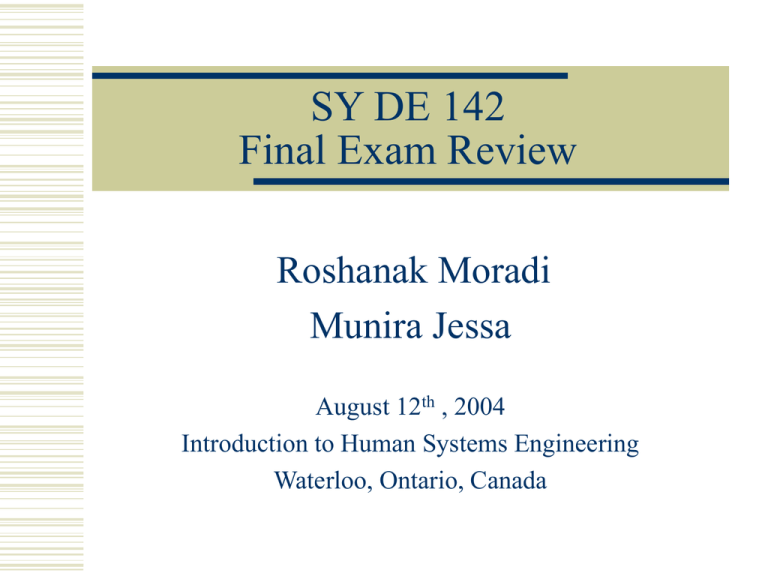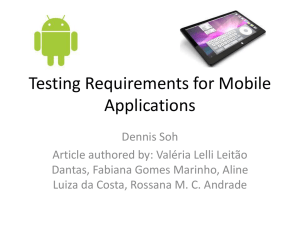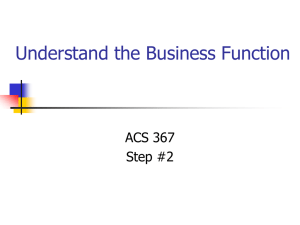Final Review - Engineering
advertisement

SY DE 142 Final Exam Review Roshanak Moradi Munira Jessa August 12th , 2004 Introduction to Human Systems Engineering Waterloo, Ontario, Canada Outline Exam Details Case Studies Course Material Exam Details Friday August 13, 2004 from 9:00 to 12:00 E2-1303 A,B, and E (NOT the regular classroom) Aids Allowed: Set Phasers on Stun, Wickens, basic calculator (not programmable) Format: Short answer questions (from case studies) Crossword puzzle Anthropometric/Biomechanical questions Case study (same as practice final) Some pointers on exam preparation Final From Last year/s - get a sense of how things went No Multiple Choice this year, you got a puzzle “ we find students know the material in a general sense, but make errors in terms of expressing things clearly, hitting all the points, thinking hard about the question and really taking the right approach etc. “ prepare by working through the web assignments. Try the case study from 3mile island and look at solutions. Critique your *solution presentation* and develop a perspective on exam writing Try to communicate with marker, be thoughtful and thorough. Watch the marks allowed on all questions. They are a strong indicator for the number of points expected. Case Studies Business in Bhopal Silent Warning In Search of the Lost Cord An Act of God The Wizards of Wall Street More Case Studies… Rental Car Set Phasers on Stun Zzzzs in Zeebrugge The Peppermint Twist Never Cry Wolf Tigershark! Return from Salyut Genie in a Bottle st 1 Accident Analysis and Fault Trees Mappings and Affordances Gulfs of Execution and Evaluation Human Action Cycle Information Processing Human Decision Making Human Error - Mistakes half Human Error- slips Human machine model Displays Control Human-Computer Interaction Usability Testing Automation nd 2 Usability Testing Stress and mental workload Circadian Rhythms/Shift work Vision Lighting & Visual Search Noise and Vibration Indoor Climate half Anthropometry Work Physiology Biomechanics Social Factors, Teamwork Transportation Personnel / Training Some notes on FTA Faulty policies are definitely factors in accidents. A fault tree analysis is nothing more than a chain of events though. Things which are overall factors are not included e.g." worker was tired/stressed/not trained". These are not events. The FTA looks at events with the object. If the user initiates an event then it can go in the analysis. The description though must be event based e.g. "machine in high radiation mode" and "activation button pressed." Note that this describes the state and the events of the object. Usability and user testing Usability Approaches (4) Cognitive walkthrough Heuristic evaluation (Neilson’s usability principals) Performance measurement Field study Tasks Usability measures (satisfaction, learnability, errors) Design for user User health and safety: Circadian Rhythms and Shiftwork Vision Health related environmental issues: Lighting Noise and Vibration Indoor climate Design for Groups Group characteristics Groupthink Social Factors, Teamwork and Communication Stress and Mental Workload Yerkes-Dodson Law Measurement: Primary Task Secondary Task Add a 2nd task and measure it Physiological Optimum Level of Arousal Speed, Accuracy Heart Rate, Blood Pressure Subjective Questionnaires Visual Search Identification of targets in a field of non-targets (distractors) Time (1 target) = (number of items x inspection time)/2 Average time, based on probability of finding a target Key points: more items=more time Only applies to very itemized searches (e.g.phone books) Vision & Lighting & Indoor Climate Visual system , Visual Fatigue Ergonomics of visual tasks Intensity measurement with their units. (Luminous Flux from source), Illumination on surface, Luminance from surface) Reflectance = Luminance (FL)/Illuminance (FC) Types of lighting in accordance to workspace (notes) Climate and air quality rules and guidelines (see notes) Anthropometrics Design Determine who the users are (the population) Determine the relevant body dimensions Determine the relevant percentage level Both male and female? Is 5th-95th range too small? Do you need both ends of the range for that problem? Don’t just use 50th percentile Anthropometrics Work Space Design Clearances: must accommodate the largest users Reach envelopes: must consider minimum reach Visibility: most comfortable visibility range Work surface height: 5-10 cm below elbow height (higher for precise work, lower for work requiring force) Link Analysis Technique for determining arrangement Spatially organize components Link by variable of interest B C P M travel time frequency of use Thickness of link represents variable Redesign to improve variable of interest P C B M Work Physiology Muscle Structure Aerobic vs Anaerobic Activity Muscle Efficiency 20% Heart Parameters: Cardiac Output Heart Rate Stroke Volume Basal metabolic rate: 1600-1800 kcal/day Short Term (Aerobic) Work Capacity about 15kcal/min men 10 kcal/min women Long Term Work Capacity suggested not over 1/3 of short term for 8 hrs Designed Rest Schedules Biomechanics of Work Statics model (F=0, Moments=0), isometric contraction L5/S1 Lumbosacral Disc (p.329) Cumulative Trauma Disorders (CTDs) Fingers, hand/wrist, elbow, shoulder tendon irritation muscle loading due to unnatural postures blood obstruction NIOSH Lifting Equation RWL = LC x HM x VM x DM x AM x FM x CM LC: load constant, maximum recommended weight HM: horizontal multiplier, decreases weight with distance from spine VM: vertical multiplier, lifting from near floor harder DM: distance multiplier, accommodates for vertical distance that must be lifted AM: asymmetric multiplier, reductions for torso twisting CM: coupling modifier, depends on whether loads have handles for lifting FM: frequency modifier, how frequently is the load lifted Multipliers can all be obtained from tables (11.1, 10.2, 10.3, 11.2, 11.3) More Transportation Tasks in driving Distractions and issues some causal factors to accidents Personnel selection Methods: Resume and Interview. Behavioral interview Various tests




